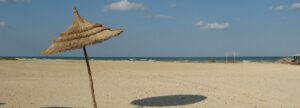| Location: |
North Africa, part of the Mahgreb States |
| Size: |
163.610,0 square kilometers, 800 km north-south, 240 km east-west. |
| Einwohner: |
approx. 12 million, of which approx. 2 million in the capital Tunis. 95% Arabs / Arabized Berbers, 5% Europeans and small Jewish community. The Berbers are the indigenous people of North Africa and were here long before the Arabs, Europeans and Romans. Berber women traditionally wear silver chains, amulets, earrings, bracelets and ankle bracelets. Their hair is often colored and their clothes are red and blue. |
| Age structure: |
0-14 years: 23%; 15-24 years: 16,5%; 25-54 years: 44,7%; 55-64 years: 8,1%; 65 years and older: 7,7% |
| Illiteracy rate: |
25,7% |
| Fertility rate: |
2,0 births / woman |
| Business languages: |
Arabic, French |
| Air conditioning: |
Mediterranean in the north, warm summer, mild winter with high rainfall. Continental and dry climate in the south. Desert climate south of the salt lake with cold winters and hot summers. In summer, the hot Scirocco wind occasionally blows from the Sahara. |
| Landscape: |
1.300 km of coastline. North: Foothills of the Atlas Mountains with large forest and game stocks, fertile Cap Bon peninsula. Center: Sahel with wide olive groves. South: stone, sand, salt desert, Matmata with cave dwellings, largest salt lake in the country Chott El Jerid. |
| Culture: |
Romans, Carthaginians and Phoenicians took turns taking power over the country. Today there are witnesses from the past in Bulla Regia, Dougga, Carthage and El Jem. Many of these excavations are well preserved and can be visited. |
| Economy: |
the most important sources of income are industry and tourism. |
| Currency: |
1 Tunisian dinar = 1000 millimes |






